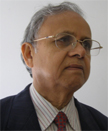The subcommittee on Oversight and Investigations of the House Committee on Foreign Affairs held a hearing on Wednesday (2/8/2012) to discuss the target killings and human rights situation in Balochistan and termed it a matter requiring urgent attention.
The hearing was chaired by Republican Congressman Dana Rohrabacher who recently co-authored an article with Congressman Louie Gohmert expressing support for an independent Balochistan. "Perhaps we should even consider support for a Balochistan carved out of Pakistan to diminish radical power there (in Pakistan)," Rohrabacher wrote in his piece.
In his submitted testimony to the committee, Amnesty International's Advocacy Director T. Kumar called on the US to "apply the Leahy Amendment without waivers to all Pakistani military units in Balochistan."
Ali Dayan Hasan, the Pakistan director for Human Rights Watch, in his testimony, said that cases documented by the HRW show that Pakistan's security forces and its intelligence agencies were involved in the enforced disappearance of ethnic Baloch. The HRW representative asked the US government in his recommendations to "communicate directly to the agencies responsible for disappearances and other abuses including the army, ISI, IB, Frontier Corps, police and other law enforcement and intelligence agencies, to demand an end to abuses and facilitate criminal inquiries to hold perpetrators accountable."
Hasan dubbed the military's role in the province as brutal, and an occupying one. He clarified that the HRW took no position on the issue of the independence of Balochistan. He argued that the US and UK had made enforced disappearances possible by allowing them during the war on terror, which has led to the military doing the same.
Dr M Hosseinbor, a Baloch lawyer and witness at the hearing, said that according to Baloch sources, nearly 4,000 people have disappeared in the province since 2001. In his submitted remarks, Mr Bor called on the US to support an independent Balochistan "in case Pakistan or Iran or both collapsed from within."
Ralph Peters' Testimony
Perhaps the most important testimony was of retired Lieutenant-Colonel Ralph Peters, the creator of the 2006 New Middle East map that showed a truncated Pakistan. In his article accompanying the map -- Blood Borders: How a better Middle East would look - published in the Armed Forces Journal in June 2006, he argued that Pakistan is an unnatural state and a natural Pakistan should lie entirely east of the Indus, except for a westward spur near Karachi. "Pakistan's Northwest Frontier tribes would be reunited with their Afghan brethren. Pakistan, another unnatural state, would also lose its Baluch territory to Free Balochistan.
His Wednesday testimony was buildup on his New Middle East map with truncated Pakistan as he said "Pakistan's borders make no sense and don't work." He went on to say:
"The Durand Line, delineating the state's border with Afghanistan, was just a convenient inheritance from British India: Originally, it established how far the British believed they needed to push out a buffer zone west of the Indus River to protect "the Jewel in the Crown," British India, from tribal warfare and imperial Russian machinations. The Durand Line marked a military frontier, but the "real" frontier of British India and its rich civilization was the Indus."
Supporting the creation of Pashtunistan by separating the northern Pashtun tribal belt along the border with Pakistan, Peter argued that why not forty million Pashtuns in Pakistan and Afghanistan their own state? " Of course, determining the final boundaries of such a state would be problematic, but why shouldn't the Pashtuns have their own country?" He went on to say that our allegiance to today's boundaries exacerbates the conflict. He argued:
"The Durand Line arbitrarily divided tribal territories for British (and now Pakistani) convenience. It would be hard to devise a more dysfunctional international border. Along with the rupture of minor ethnic groups, it split the substantial Pashtun and Baluchi populations between the artificial constructs that emerged as Pakistan and Afghanistan. Also for convenience, the rest of the world agreed to pretend that these are viable states. Yet, Afghanistan is little more than a rough territorial concept: Its historical rulers controlled, at best, major cities and the caravan (now highway) routes between them. At its birth sixty-five years ago, Pakistan was a Frankenstein's monster of a state, cobbled together from ill-fitting body parts to award the subcontinent's Muslim activists a state of their own."
Repeating his argument of the New Middle East, Peters said at present, the Baluchis are divided between southwestern Pakistan, southern Afghanistan and southeastern Iran--all because of those artificial borders that were convenient for someone else. "At least ten million and perhaps twice that number suffer intolerable levels of discrimination, dispossession and state violence," he said adding:
We need to ask honestly why Baluchis are not entitled to a Free Balochistan, why the Pashtuns--despite their abhorrent customs--are not entitled to a Pakhtunkhwa for all Pashtuns, why forty-million Kurds aren't entitled to a Free Kurdistan, or why its eastern provinces must remain part of the geopolitical monstrosity we call "Congo."
The map of the "New Middle East" was a key element in the retired Lieutenant-Colonel's book, Never Quit the Fight , which was released to the public in July 2006. The concept of a redrawn Middle East has been presented as a "humanitarian" and "righteous" arrangement that would benefit the people of the Middle East and its peripheral regions. According to Ralph Peter's:
"International borders are never completely just. But the degree of injustice they inflict upon those whom frontiers force together or separate makes an enormous difference -- often the difference between freedom and oppression, tolerance and atrocity, the rule of law and terrorism, or even peace and war.
(Note: You can view every article as one long page if you sign up as an Advocate Member, or higher).





